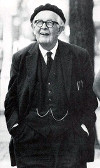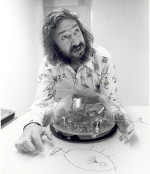Logo and Learning

Jean Piaget
The Logo philosophy of education is best described as Constructivism, a theory of learning formulated by Jean Piaget. Constructivism conceives of learning as a process in which learners create knowledge in their minds as they interact with things and people in the world around them. Seymour Papert, who was part of the team that first developed Logo, and is often referred to as the "father of Logo," worked closely with Piaget at the Center for Genetic Epistemology in Geneva from 1958 to 1963 before moving to the United States where he was the co-founder of the Artificial Intelligence Laboratory at the Massachusetts Institute of Technology. So it is not surprising that Logo has roots in Piaget's work. Logo is designed to be an environment in which Piagetian learning can occur and is supported.
Papert's widely read and highly influential book Mindstorms was published in 1981, just around the time that microcomputers were starting to find their way in to classrooms. The book begins with an affirmation of the importance of making a personal connection with one's own learning and ends with an examination of the social context in which learning occurs. In the intervening chapters, learning in a computer culture is situated in the context of Piaget's work and in the field of artificial intelligence. A significant part of the book is devoted to the idea of a "mathland" – an environment in which people can learn mathematics naturally as they learn to speak their native language without formal instruction. Turtle Geometry is a part of this mathland, a mathematics that is more accessible to young learners than the familiar forms of geometry taught in schools.

Seymour Papert with a robot Turtle
Papert and his colleagues in the Epistemology and Learning
Group at the MIT Media Lab developed the concept of
Constructionism, which extended the Constructivism of Piaget to
include the idea that a good way to support the building of
knowledge in one's head is to build something in the real world
– a computer program, a robot, a drawing, a story, or a musical
composition. Constructionism is both a theory of learning and a
strategy of education that guides teaching and the design of
learning environments.
The Logo philosophy has similarities with educational theories
and practices that are referred to as child-centered,
learner-centered, progressive, active, hands-on, or
project-based. To the extent that these approaches emphasize the
agency of the learner, they are in harmony with the Logo
philosophy of learning.
For a fuller discussion of Logo and learning, read Mindstorms.
Another excellent book is Computer
Environments for Children, by Cynthia Solomon, which
situates Papert's approach to using computers in education with
those of other educators. Two collections of essays, Constructionism
and Constructionism
in Practice, offer a wide-ranging picture of
Constructionist theory and practice.